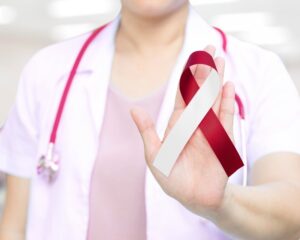
If you’ve seen the burgundy and white ribbons while going about your day, you’re probably wondering what they mean. These are the cancer ribbons for oral cancer. April is Oral Cancer Awareness Month, so it’s no surprise to see them out and about this time of year.
Wondering how you can participate? You’re already off to a good start! There are some easy actionable things you can do to honor April, such as getting an oral cancer screening. Keep reading to increase your oral cancer awareness and find out what you can do to keep it out of your mouth.
Oral Cancer Overview
Oral cancer can appear on the lips, gums, tongue, or inner mouth. Like all other cancers, it occurs when mutations change a cell’s DNA. It’s unclear what exactly causes these mutations. Though it seems certain factors contribute to oral cancer, a cure has yet to be found. Most medical professionals categorize oral cancer into the larger umbrella of head and neck cancers.
What Does Oral Cancer Look Like?
In broad terms, oral cancer manifests as abnormal patches of skin in the oral region, complications with the jaw, and irregularities in the throat. More specifically, it can look like:
- A horn-like growth
- Sores
- Crusty skin
- Tender oral tissues
- Unexplained changes in voice
- Oral discoloration
This is far from a complete list of oral cancer symptoms, which is why it’s important to visit your dentist. Two simple checkups a year can make a world of difference by giving you and your dentist a better chance of catching oral cancer in the early stages.
What Can Contribute to Oral Cancer?
The Head and Neck Cancer Alliance identifies tobacco and alcohol as the leading contributors to oral cancer. Other factors that can increase your risk include sun exposure, poor oral hygiene, and the HPV virus.
How to Mitigate Risk
As acknowledged, there’s no “miracle cure” for oral cancer. However, there are ways you can reduce your risk and catch it before it spreads.
- Avoid all forms of tobacco. Health professionals recommend avoiding smoked and unsmoked sources of tobacco.
- Moderate alcohol consumption. While the general preference is to not consume any alcohol, it becomes truly dangerous in repeated, excessive use.
- Maintain oral hygiene. It’s good to brush twice per day and floss every day, but you should also visit your dentist for professional, routine cleanings twice a year.
- Ask your dentist for an oral cancer screening. Identifying oral cancer while it’s still in the early stages drastically increases your survival rate.
Even if you’re a healthy individual, you should still visit your dentist for regular checkups and oral cancer screenings. The unfortunate reality is that you can mitigate your cancer risk, but never completely reduce it to zero. There are cases of perfectly healthy people developing oral cancer.
Actionable Solutions – Get a Screening!
Fortunately, screening for oral cancer is much simpler and less invasive than screening for stomach or breast cancers. Your dentist can typically perform a screening during your bi-annual checkup and cleaning without needing extra equipment. Plus, if you have dental insurance, it’s likely your bi-annual checkups are free. So if you haven’t already, call your dentist and honor Oral Cancer Awareness Month by asking for an oral screening!
About the Author
Dr. Zachary Brice is committed to keeping up with emerging technologies and information to ensure he provides you with the best care possible. He’ll help you keep an eye on your oral health and would love to give you more recommendations for oral cancer prevention. To schedule a checkup, call his office at 210-903-5565 or visit his website.
